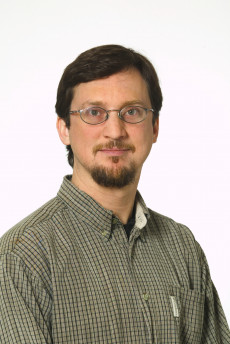John Shalf has been named the Chief Technology Officer (CTO) of the National Energy Research Scientific Computing (NERSC) Division at Lawrence Berkeley National Laboratory (Berkeley Lab) by NERSC Director Sudip Dosanjh. Shalf will also continue to serve in his current role as head of the Computer and Data Sciences Department in Berkeley Lab’s Computational Research Division (CRD).
NERSC is the primary high performance computing (HPC) facility for scientific research sponsored by the U.S. Department of Energy’s (DOE’s) Office of Science. As Chief Technology Officer, Shalf will help NERSC develop a plan to achieve exascale performance—1 quintillion or 10¹⁸ computer operations per second—a thousand-fold increase over current petascale systems. Exascale is expected to require computers containing 10 million to 100 million processing elements or cores, as well as new programming techniques and software. Shalf will also help coordinate exascale research activities with future NERSC procurements.
“NERSC is responsible for moving hundreds of science codes that serve the diverse needs of the Office of Science to next generation architectures,” Dosanjh said. “Because of the breadth of our applications, we cannot build application-specific architectures—rather, we must broadly support DOE’s mission. This poses special challenges for data movement (memory and interconnect being examples). Our goal is to ensure that scientific progress is uninterrupted on the road to exascale. John’s demonstrated intellectual leadership in advanced architecture development will help NERSC choose the most productive path forward.
Shalf added, “A key goal of DOE’s exascale program is to develop high performance scientific computers that deliver a thousand times the performance of today’s most powerful computers at all scales, while using less than twice the power, by the end of the next decade. The demands of energy efficiency are driving deep changes that will change the way we do computing at all scales, not just exascale. NERSC will take an active role to work with industry as a public/private partnership to guide HPC designs and bring the DOE user community along in this time of great transition.”
Shalf has served on the DOE Exascale Steering Committee and is co-principal investigator of the Computer Architecture Laboratory (CAL), a joint activity of Sandia National Laboratories and Lawrence Berkeley National Laboratory for the DOE Office of Advanced Scientific Computing Research. CAL is coordinating hardware architecture research and development activities across the DOE. He also leads the CRD/NERSC Green Flash project, which is developing a novel HPC system design (hardware and software) for kilometer-scale global climate modeling that is hundreds of times more energy efficient than conventional approaches.
Kathy Yelick, Associate Laboratory Director for Computing Sciences, views Shalf’s appointment as an important step in combining in the organization’s research and facilities expertise to address the challenges to continue growing computing performance for science. Computing Sciences, which comprises NERSC, CRD and ESnet, provides the high performance computing and networking resources and the applied math and computer science tools and technologies needed to advance computational science.
CRD Director David Brown said Shalf’s dual role will promote closer ties between NERSC and CRD to support Computing Sciences’ strategic efforts for exascale computing and science engagement at the lab. “As computation plays an increasingly important role in research from accelerators and astrophysics to materials and genomics, John’s expertise and experience in both applications and software should lead to greater strategic collaboration between NERSC, CRD and the other scientific divisions at Berkeley Lab,” Brown said.
Shalf is a co-author of over 60 publications in the field of software frameworks and HPC technology, including three best papers and the widely cited report “The Landscape of Parallel Computing Research: A View from Berkeley” (with David Patterson and others), as well as “ExaScale Software Study: Software Challenges in Extreme Scale Systems,” which sets the Defense Advanced Research Project Agency’s (DARPA’s) information technology research investment strategy for the next decade. He was a member of the Berkeley Lab/NERSC team that won a 2002 R&D 100 Award for the RAGE robot.
Shalf received a bachelor’s degree in electrical engineering and a master’s degree in computer engineering from Virginia Polytechnic Institute and State University. Before joining Berkeley Lab in 2000, he was a research programmer at the National Center for Supercomputing Applications at the University of Illinois and a visiting scientist at the Max-Planck-Institut für Gravitationphysick/Albert Einstein Institute in Potsdam, Germany, where he co-developed the Cactus code framework for computational astrophysics.
About Berkeley Lab
Founded in 1931 on the belief that the biggest scientific challenges are best addressed by teams, Lawrence Berkeley National Laboratory and its scientists have been recognized with 16 Nobel Prizes. Today, Berkeley Lab researchers develop sustainable energy and environmental solutions, create useful new materials, advance the frontiers of computing, and probe the mysteries of life, matter, and the universe. Scientists from around the world rely on the Lab’s facilities for their own discovery science. Berkeley Lab is a multiprogram national laboratory, managed by the University of California for the U.S. Department of Energy’s Office of Science.
DOE’s Office of Science is the single largest supporter of basic research in the physical sciences in the United States, and is working to address some of the most pressing challenges of our time. For more information, please visit energy.gov/science.










